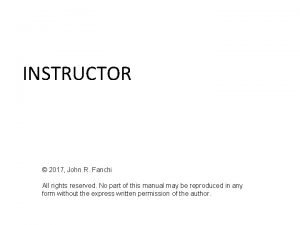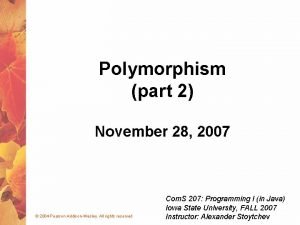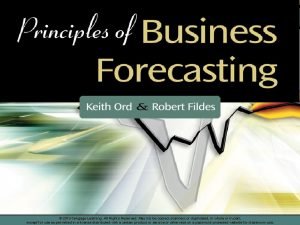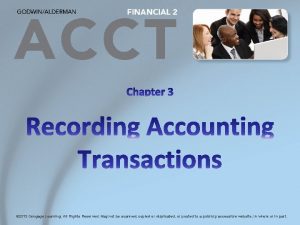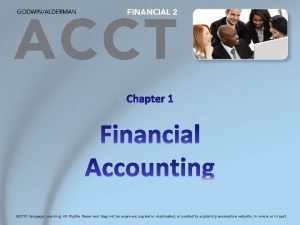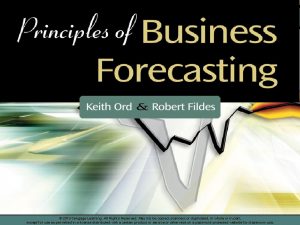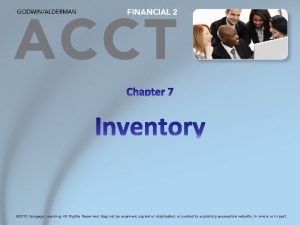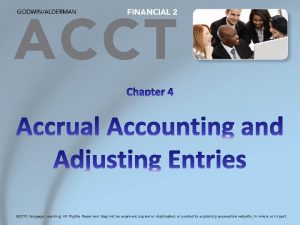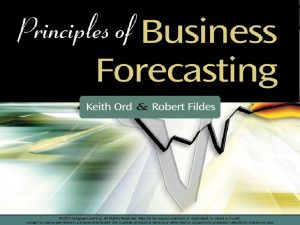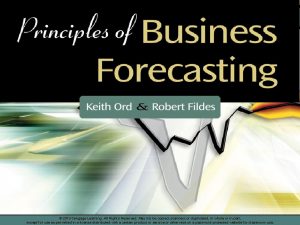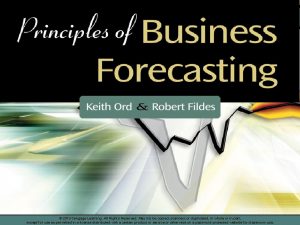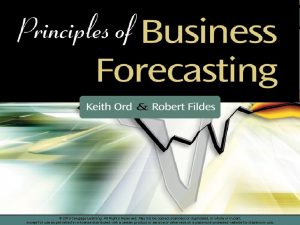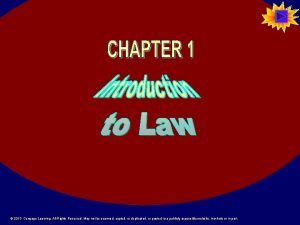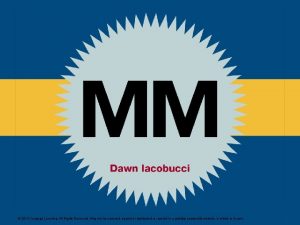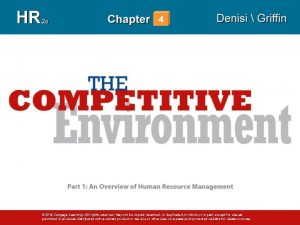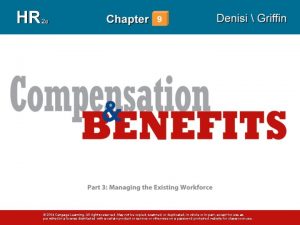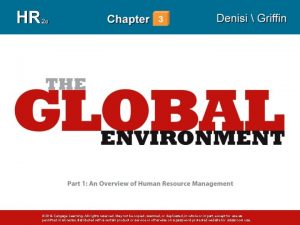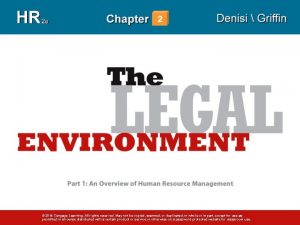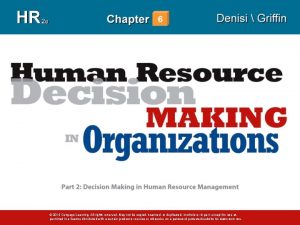2013 Cengage Learning All Rights Reserved May not

































![6. 10: GARCH Models • Generalized Autoregressive Conditional Heteroscedastic [GARCH] models provide descriptions of 6. 10: GARCH Models • Generalized Autoregressive Conditional Heteroscedastic [GARCH] models provide descriptions of](https://slidetodoc.com/presentation_image/3c253f6adcd054708f5692ce9bfd5451/image-34.jpg)




- Slides: 38

© 2013 Cengage Learning. All Rights Reserved. May not be copied, scanned, or duplicated, in whole or in part, except for use as permitted in a license distributed with a certain product or service or otherwise on a password-protected website for classroom use.

Chapter 6: Autoregressive Integrated Moving Average (ARIMA) Models 6. 1 The Sample Autocorrelation Function 6. 2 Autoregressive Moving Average (ARMA) Models 6. 3 Partial Autocorrelations and Model Selection 6. 4 Model Estimation and Selection 6. 5 Model Diagnostics 6. 6 Outliers 6. 7 Forecasting with ARIMA Models 6. 8 Seasonal ARIMA Models 6. 9 State-Space and ARIMA Models 6. 10 GARCH Models 6. 11 Principles of ARIMA Modeling © 2013 Cengage Learning. All Rights Reserved. May not be copied, scanned, or duplicated, in whole or in part, except for use as permitted in a license distributed with a certain product or service or otherwise on a password-protected website for classroom use. 2

6. 1: The Sample Autocorrelation Function • The first order (or lag 1) autocorrelation measures the correlation between successive observations in a time series. • The sample value is computed as: Q: Why do we use a common mean? Q: Why don’t we adjust for the fact that the denominator has n terms whereas the numerator has only (n-1). 3 © 2013 Cengage Learning. All Rights Reserved. May not be copied, scanned, or duplicated, in whole or in part, except for use as permitted in a license distributed with a certain product or service or otherwise on a password-protected website for classroom use.

6. 1: The Sample Autocorrelation Function Example 6. 1: Calculation of First-Order Autocorrelation 4 © 2013 Cengage Learning. All Rights Reserved. May not be copied, scanned, or duplicated, in whole or in part, except for use as permitted in a license distributed with a certain product or service or otherwise on a password-protected website for classroom use.

6. 1: The Sample Autocorrelation Function • Higher order autocorrelations: The sample function for lag k is: • The plot of rk against k for k=1, 2, … is known as the sample autocorrelation function (ACF), typically plotted for the first n/4 lags or thereabouts. • The plot is supplemented with 5% significance limits to enable a graphical check of whether dependence exists at a given lag. 5 © 2013 Cengage Learning. All Rights Reserved. May not be copied, scanned, or duplicated, in whole or in part, except for use as permitted in a license distributed with a certain product or service or otherwise on a password-protected website for classroom use.

6. 1: The Sample Autocorrelation Function Example 6. 2: The Autocorrelation Function for WFJ Sales 6 © 2013 Cengage Learning. All Rights Reserved. May not be copied, scanned, or duplicated, in whole or in part, except for use as permitted in a license distributed with a certain product or service or otherwise on a password-protected website for classroom use.

6. 1. 1: Model Assumptions • A time series is stationary if it has a constant mean and variance and its autocorrelations depend only on the relative time between the observations. Formally, we introduce the notation ω2 for the variance of Y and ρk to denote the autocorrelation at lag k. Then, for stationarity, we require that Q: Can you suggest series that might be stationary? Also suggest series that may be non-stationary in either the mean or the variance or both. © 2013 Cengage Learning. All Rights Reserved. May not be copied, scanned, or duplicated, in whole or in part, except for use as permitted in a license distributed with a certain product or service or otherwise on a password-protected website for classroom use. 7

6. 2: Autoregressive Moving Average (ARMA) Models • The autoregressive model of lag 1, written as AR(1) is: • Assumptions regarding the error term are the same as before: o Zero mean, constant variance, and mutually uncorrelated o The model is stationary if and only if • Stationary models have unconditional mean, variance and autocorrelations that do not depend on time t: 8 © 2013 Cengage Learning. All Rights Reserved. May not be copied, scanned, or duplicated, in whole or in part, except for use as permitted in a license distributed with a certain product or service or otherwise on a password-protected website for classroom use.

6. 2: Autoregressive Moving Average (ARMA) Models Q: Why do even-numbered lags have positive autocorrelation even when the coefficient is negative? Sample ACFs will not look exactly like theoretical forms! 9 © 2013 Cengage Learning. All Rights Reserved. May not be copied, scanned, or duplicated, in whole or in part, except for use as permitted in a license distributed with a certain product or service or otherwise on a password-protected website for classroom use.

6. 2: Autoregressive Moving Average (ARMA) Models • Higher order AR models have more complex ACF patterns. Q: What would the ACF look like when both coefficients ϕ 1 and ϕ 2 are negative? © 2013 Cengage Learning. All Rights Reserved. May not be copied, scanned, or duplicated, in whole or in part, except for use as permitted in a license distributed with a certain product or service or otherwise on a password-protected website for classroom use. 10

6. 2: Autoregressive Moving Average (ARMA) Models • Moving Average models have a simple ACF structure. Q: What would the ACF for an MA(2) scheme look like? 11 © 2013 Cengage Learning. All Rights Reserved. May not be copied, scanned, or duplicated, in whole or in part, except for use as permitted in a license distributed with a certain product or service or otherwise on a password-protected website for classroom use.

6. 3: Partial Autocorrelations and Model Selection • For k = 1, 2, …, fit an AR scheme of order k to the data and record the value of the autoregressive coefficient for lag k. Denote this quantity by Ck. • The plot Ck against k (=1, 2, 3, …) is the Partial Autocorrelation Function (PACF). For an AR(p) scheme, only the first p values will be nonzero. 12 © 2013 Cengage Learning. All Rights Reserved. May not be copied, scanned, or duplicated, in whole or in part, except for use as permitted in a license distributed with a certain product or service or otherwise on a password-protected website for classroom use.

6. 3: Partial Autocorrelations and Model Selection • A model may have both autoregressive and moving average components. The ARMA(1, 1) scheme has the form: . Such mixed models have non-vanishing terms in both the ACF and the PACF. 13 © 2013 Cengage Learning. All Rights Reserved. May not be copied, scanned, or duplicated, in whole or in part, except for use as permitted in a license distributed with a certain product or service or otherwise on a password-protected website for classroom use.

6. 3: Partial Autocorrelations and Model Selection 14 © 2013 Cengage Learning. All Rights Reserved. May not be copied, scanned, or duplicated, in whole or in part, except for use as permitted in a license distributed with a certain product or service or otherwise on a password-protected website for classroom use.

6. 3: Partial Autocorrelations and Model Selection Q: Which model would you suggest for WFJ Sales? The golden rule is to be parsimonious: pick the simplest model that seems to work. 15 © 2013 Cengage Learning. All Rights Reserved. May not be copied, scanned, or duplicated, in whole or in part, except for use as permitted in a license distributed with a certain product or service or otherwise on a password-protected website for classroom use.

6. 3: Partial Autocorrelations and Model Selection • When the series is non-stationary consider using a difference. The first order difference is: • Converting to “Growth” is another option • The ACF and PACF for Netflix sales are typical of non-stationary series [Netflix. xlsx] • Note that the PACF displays the “Pollyanna effect” 16 © 2013 Cengage Learning. All Rights Reserved. May not be copied, scanned, or duplicated, in whole or in part, except for use as permitted in a license distributed with a certain product or service or otherwise on a password-protected website for classroom use.

6. 3. 4: The Random Walk • The Random Walk is defined by the simple model: • That is, the best forecast for the next period is the previous observation Four Random Walks Q: The random walk is the standard model for stock prices. Why? 17 © 2013 Cengage Learning. All Rights Reserved. May not be copied, scanned, or duplicated, in whole or in part, except for use as permitted in a license distributed with a certain product or service or otherwise on a password-protected website for classroom use.

Figure 6. 14: ACF and PACF for Random Walk and its First Difference 18 © 2013 Cengage Learning. All Rights Reserved. May not be copied, scanned, or duplicated, in whole or in part, except for use as permitted in a license distributed with a certain product or service or otherwise on a password-protected website for classroom use.

6. 4: Model Estimation and Selection • Use the initial data plot, the ACF and the PACF to suggest possible models • Examine the performance of the several models selected Q: Choose the better model. Which criterion would you use? 19 © 2013 Cengage Learning. All Rights Reserved. May not be copied, scanned, or duplicated, in whole or in part, except for use as permitted in a license distributed with a certain product or service or otherwise on a password-protected website for classroom use.

6. 4: Model Estimation and Selection Example 6. 6: Fitted Model for WFJ Sales Q: Which Model? 20 © 2013 Cengage Learning. All Rights Reserved. May not be copied, scanned, or duplicated, in whole or in part, except for use as permitted in a license distributed with a certain product or service or otherwise on a password-protected website for classroom use.

6. 4: Model Estimation and Selection Example 6. 8: Fitted Model for U. S. Retail Sales Q: Should we difference? Which model would you suggest? 21 © 2013 Cengage Learning. All Rights Reserved. May not be copied, scanned, or duplicated, in whole or in part, except for use as permitted in a license distributed with a certain product or service or otherwise on a password-protected website for classroom use.

6. 4. 2: Use of Information Criteria • Use either Q: Which criterion is likely to select the more complex model? Why? • p = NP =number of parameters 22 © 2013 Cengage Learning. All Rights Reserved. May not be copied, scanned, or duplicated, in whole or in part, except for use as permitted in a license distributed with a certain product or service or otherwise on a password-protected website for classroom use.

6. 5: Model Diagnostics • What can go wrong? o The errors may not be normally distributed. o The data may contain outliers. o The errors may be autocorrelated. o The time series may be non-stationary. o The errors may show changing variances over time. o The mean of the errors may be non-zero (only applies when the model does not contain a constant term). • How do we check for these problems and what do we do about them? 23 © 2013 Cengage Learning. All Rights Reserved. May not be copied, scanned, or duplicated, in whole or in part, except for use as permitted in a license distributed with a certain product or service or otherwise on a password-protected website for classroom use.

6. 5: Model Diagnostics (Continued) 24 © 2013 Cengage Learning. All Rights Reserved. May not be copied, scanned, or duplicated, in whole or in part, except for use as permitted in a license distributed with a certain product or service or otherwise on a password-protected website for classroom use.

6. 5: Model Diagnostics (Continued) 25 © 2013 Cengage Learning. All Rights Reserved. May not be copied, scanned, or duplicated, in whole or in part, except for use as permitted in a license distributed with a certain product or service or otherwise on a password-protected website for classroom use.

6. 5: Model Diagnostics Figure 6. 17: Residual Plots for ARIMA (1, 1, 0) Model for U. S. Retail Sales ARIMA(0, 1, 1) Figure 6. 19: Residuals Plots for ARIMA (0, 1, 1)+C Model for U. S. Retail Sales ARIMA(0, 1, 1) +C Q: What are the differences between the two sets of plots? 26 © 2013 Cengage Learning. All Rights Reserved. May not be copied, scanned, or duplicated, in whole or in part, except for use as permitted in a license distributed with a certain product or service or otherwise on a password-protected website for classroom use.

6. 5: Model Diagnostics The Ljung-Box statistic tests for the presence of autocorrelation: Example 6. 9: An Application of the Ljung-Box Statistic to the U. S. Retail Sales Model Q: Is the model adequate for short-term forecasting? 27 © 2013 Cengage Learning. All Rights Reserved. May not be copied, scanned, or duplicated, in whole or in part, except for use as permitted in a license distributed with a certain product or service or otherwise on a password-protected website for classroom use.

6. 6: Outliers Again • After adjusting for the October 2001 outlier in the U. S. Retail Sales series, the diagnostics are as shown below. What conclusions may be drawn? Figure 6. 19: Residual Plots for ARIMA (0, 1, 1)+C Model for U. S. Retail Sales Original Figure 6. 20: Residuals Plots for U. S. Retail Sales, After Adjusting for the Outlier After removing outlier 28 © 2013 Cengage Learning. All Rights Reserved. May not be copied, scanned, or duplicated, in whole or in part, except for use as permitted in a license distributed with a certain product or service or otherwise on a password-protected website for classroom use.

6. 7: Forecasting with ARIMA Models Example 6. 11 Forecasting for WFJ Sales using AR(1) and ARIMA(0, 1, 1) Yt values: Use observations already recorded where available; for values not yet recorded, insert the latest available forecast. εt values: Use recorded one-step-ahead residuals where available; set future errors in the equation equal to zero (best available forecast). Model: One-step-ahead forecast: 29 © 2013 Cengage Learning. All Rights Reserved. May not be copied, scanned, or duplicated, in whole or in part, except for use as permitted in a license distributed with a certain product or service or otherwise on a password-protected website for classroom use.

6. 7. 1: Prediction Intervals • In most cases, it suffices to compute the h-step-ahead mean square error and then construct the prediction interval as in earlier chapters. • For stationary models, the long-term forecast approaches the mean and the MSE approaches a fixed value. For non-stationary series, the MSE increases without limit. 30 © 2013 Cengage Learning. All Rights Reserved. May not be copied, scanned, or duplicated, in whole or in part, except for use as permitted in a license distributed with a certain product or service or otherwise on a password-protected website for classroom use.

6. 7. 2: Forecasting Using Transformations • Transform the series. • Generate the point forecasts and prediction intervals for the transformed series. • Convert the point forecasts and prediction intervals back to the original units. • The prediction interval based upon a transformation will usually not be symmetric. 31 © 2013 Cengage Learning. All Rights Reserved. May not be copied, scanned, or duplicated, in whole or in part, except for use as permitted in a license distributed with a certain product or service or otherwise on a password-protected website for classroom use.

6. 8: Seasonal ARIMA Models • Combine regular and seasonal components. • May need both regular and seasonal differences. • The popular “airline model” is ARIMA(0, 1, 1)m. Example 6. 15: Seasonal Model for UK Retail Sales Q: What are the potential weaknesses of this model? © 2013 Cengage Learning. All Rights Reserved. May not be copied, scanned, or duplicated, in whole or in part, except for use as permitted in a license distributed with a certain product or service or otherwise on a password-protected website for classroom use. 32

6. 9: State-Space and ARIMA Models • We can express a linear state-space scheme in ARIMA form if and only if we assume that the random error terms satisfy the standard assumptions. • Any ARIMA scheme may be expressed in state-space form. 33 © 2013 Cengage Learning. All Rights Reserved. May not be copied, scanned, or duplicated, in whole or in part, except for use as permitted in a license distributed with a certain product or service or otherwise on a password-protected website for classroom use.
![6 10 GARCH Models Generalized Autoregressive Conditional Heteroscedastic GARCH models provide descriptions of 6. 10: GARCH Models • Generalized Autoregressive Conditional Heteroscedastic [GARCH] models provide descriptions of](https://slidetodoc.com/presentation_image/3c253f6adcd054708f5692ce9bfd5451/image-34.jpg)
6. 10: GARCH Models • Generalized Autoregressive Conditional Heteroscedastic [GARCH] models provide descriptions of how the error variance evolves over time. • The most commonly used model is the GARCH(1, 1) scheme: • • denotes the variance at time t and error at time t-1. is the squared are parameters subject to the conditions: 34 © 2013 Cengage Learning. All Rights Reserved. May not be copied, scanned, or duplicated, in whole or in part, except for use as permitted in a license distributed with a certain product or service or otherwise on a password-protected website for classroom use.

6. 10: GARCH Models Example 6. 19: Variation in the Dow Jones Index Q: Interpret the coefficients. 35 © 2013 Cengage Learning. All Rights Reserved. May not be copied, scanned, or duplicated, in whole or in part, except for use as permitted in a license distributed with a certain product or service or otherwise on a password-protected website for classroom use.

6. 11: Principles of ARIMA Modeling • Identify the key features of the data. • Transform the data to stationarity. • Consider a variety of models, compatible with time series characteristics. • Estimate the models, using your preferred software. • Examine the diagnostic statistics-in particular, the residual autocorrelations. • Consider simplifying the model if the coefficients are insignificant. • Use an information criterion supplemented, where possible, by an out-of-sample fit to choose among models. • Compare your ARIMA forecasts with alternative methods of forecasting - in particular, with a naïve model. 36 © 2013 Cengage Learning. All Rights Reserved. May not be copied, scanned, or duplicated, in whole or in part, except for use as permitted in a license distributed with a certain product or service or otherwise on a password-protected website for classroom use.

6. 11. 2: GARCH Models • Start with a constant variance model, and then examine the autocorrelation structure of the squared residuals, using the methods of this chapter. • The GARCH(1, 1) model will suffice for most purposes. • Remember KISS (Keep It Simple, Statistician)! 37 © 2013 Cengage Learning. All Rights Reserved. May not be copied, scanned, or duplicated, in whole or in part, except for use as permitted in a license distributed with a certain product or service or otherwise on a password-protected website for classroom use.

Take-Aways • The Box-Jenkins or ARIMA approach provides a framework for model selection, estimation and forecasting. • The ACF and PACF are the primary tools for model selection and they are also useful as diagnostic devices. • ARIMA models require the time series to be stationary or to be transformed to stationarity. Typically business series will require differencing and/or transformations to achieve this condition. • There is a general equivalence between linear state-space models and ARIMA models. However, the actual models selected in an application may well differ. • GARCH models provide for changing variances to complement the changes in the mean level. 38 © 2013 Cengage Learning. All Rights Reserved. May not be copied, scanned, or duplicated, in whole or in part, except for use as permitted in a license distributed with a certain product or service or otherwise on a password-protected website for classroom use.
 Cengage learning 2013
Cengage learning 2013 Specification by example
Specification by example Copyright 2015 all rights reserved
Copyright 2015 all rights reserved All rights reserved sentence
All rights reserved sentence Creative commons vs all rights reserved
Creative commons vs all rights reserved Confidential all rights reserved
Confidential all rights reserved All rights reserved example
All rights reserved example Copyright 2015 all rights reserved
Copyright 2015 all rights reserved 2012 pearson education inc
2012 pearson education inc Microsoft corporation. all rights reserved.
Microsoft corporation. all rights reserved. Microsoft corporation. all rights reserved.
Microsoft corporation. all rights reserved. Microsoft corporation. all rights reserved.
Microsoft corporation. all rights reserved. Pearson education inc. all rights reserved
Pearson education inc. all rights reserved Dell all rights reserved copyright 2009
Dell all rights reserved copyright 2009 Warning all rights reserved
Warning all rights reserved C all rights reserved
C all rights reserved Quadratic equation cengage
Quadratic equation cengage Warning all rights reserved
Warning all rights reserved Confidential all rights reserved
Confidential all rights reserved Microsoft corporation. all rights reserved
Microsoft corporation. all rights reserved 2010 pearson education inc
2010 pearson education inc Copyright © 2018 all rights reserved
Copyright © 2018 all rights reserved Gssllc
Gssllc Copyright 2010 pearson education inc
Copyright 2010 pearson education inc Pearson education inc. all rights reserved
Pearson education inc. all rights reserved Confidential all rights reserved
Confidential all rights reserved Confidential all rights reserved
Confidential all rights reserved R rights reserved
R rights reserved Rights reserved
Rights reserved Hci design patterns
Hci design patterns Chapter 6:2 interpreting word parts
Chapter 6:2 interpreting word parts Chapter 5 the cardiovascular system
Chapter 5 the cardiovascular system Cengage learning heart diagram
Cengage learning heart diagram South-western cengage learning
South-western cengage learning Chapter 13 medical math assignment sheet cengage learning
Chapter 13 medical math assignment sheet cengage learning 2009 delmar cengage learning
2009 delmar cengage learning Cengage learning heart diagram
Cengage learning heart diagram Delmar learning medical abbreviations
Delmar learning medical abbreviations Cengage learning australia
Cengage learning australia



























